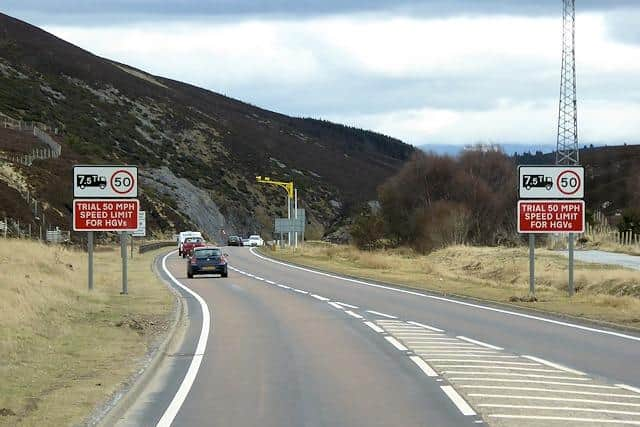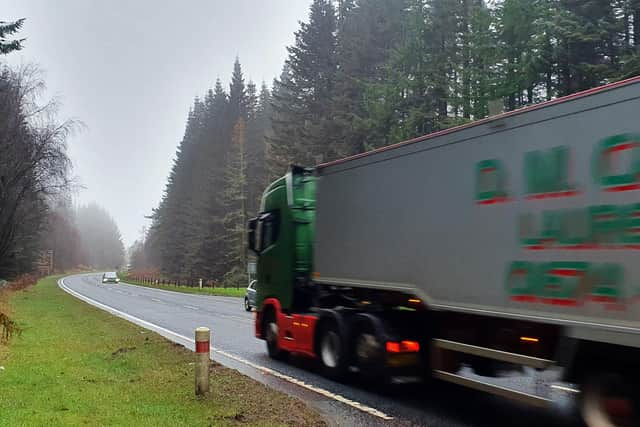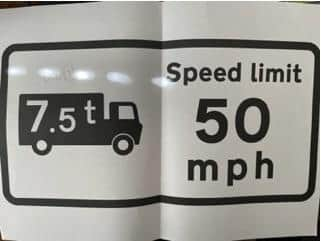A9: Higher speed limit signs for lorries on Scotland road are slowing down some cars
Signs which raised the speed limit for lorries on the A9 are forcing some cars to slow down, The Scotsman has learned.
The 50mph signs were put up as part of a trial for heavy goods vehicles (HGVs) on single-carriageway sections of the road. However, they are being misrecognised by newer cars equipped to identify speed limits as applying to them too.
Advertisement
Hide AdAdvertisement
Hide AdThis has caused such models being driven on cruise control to suddenly slow down, or trigger beeps or other warnings to their drivers. One Tesla driver said it prevented the car being driven in Autopilot mode at the 60mph speed limit for cars on those sections of the road.


The problem has prompted roads officials to order replacement signs. But it has also highlighted the lack of a decision on whether the higher limit for lorries above 7.5 tonnes should be made permanent – and extended to other single-carriageway roads.
The experimental increase from 40mph was introduced in 2014 to coincide with average speed cameras being deployed on two-lane sections of the A9 between Inverness and Perth.
The three-year pilot finished in 2017 and was evaluated the following year by the Scottish Government’s Transport Scotland agency.
It found the difference in speed between lorries and cars had narrowed, which addressed one of the main causes of driver frustration of being stuck behind a slower HGV, but average journey times increased as a result. There was also a reduction in collisions involving risky overtaking.


However, five years on, no decision has been taken on the 50mph lorry limit, which has been in force on single carriageway roads in England and Wales since 2015. Instead, the agency said the issue would be considered as part of a planned national speed management review, but no date for its launch has been announced.
The IAM RoadSmart motoring group called for the higher limit to be introduced across Scotland "as soon as possible”.
Neil Greig, its policy and research director and a member of the official A9 Safety Group, said: “The 50mph experiment on the A9 has been a success, and research from down south also confirms no safety issues around higher speeds for lorries on single carriageways.
Advertisement
Hide AdAdvertisement
Hide Ad

"Rather than simply dealing with the unintended consequences of a speed limit that only applies on the A9, the Scottish Government should adopt the higher limit on all roads in Scotland as soon as possible.
"This story also shows the critical need for high-quality and consistent signposting as more and more cars come onto our roads fitted with the latest camera detection equipment. Speed limit warnings simply won’t work if the car can’t detect and understand what it is seeing and alert the driver.”
The Road Haulage Association (RHA) said the 50mph lorry limit had reduced frustration among other drivers and called for the speed management review to be get underway “with haste”.
Martin Reid, its policy director for Scotland, Wales and Northern Ireland, said: “The spike in fatal accidents in 2022/23 shows there is still work to be done around safety when using the A9.
"The RHA is encouraged to see the temporary measures that have been put in place to aid visibility on the route and we fully support the ‘Fatigue’ and the ‘Drive on the Left’ campaigns, which have aired recently.
"The A9 remains as the only road in Scotland where HGVs can travel at 50mph on single carriage roads and this reduction in the speed differential between cars and HGVs has reduced driver frustration and led to a better driving experience for all using the route.
"To this end, we would urge the Scottish Government to move with haste in conducting and implementing the promised speed management review for the whole country.
"However, more can be done to reduce confusion on the A9 by replacing signage referring to the HGV speed trial that ended in 2018 with clearer, up-to-date versions. This is particularly pertinent while work is carried out and speed limits for all vehicles can vary along the route.”
Advertisement
Hide AdAdvertisement
Hide AdLogistics UK, which represents the haulage industry, had urged Transport Scotland to consider also raising the lorry limit to 50mph on the A75 between the M6 and the ferry ports at Cairnryan five years ago "to keep this key economic corridor to and from Northern Ireland open and functioning efficiently”.
Jonathan Walker, its head of cities and infrastructure policy, said: “We are focused on ensuring the safety of all road users, while also seeking improvements to the efficiency of deliveries being made across Scotland and beyond.
"We continue to liaise with the Scottish Government to ensure that freight is at the forefront of transport policy, while any changes to legislation are to the benefit of all those travelling on Scotland’s roads.”
Transport Scotland said a prototype 50mph sign without the traditional red speed limit roundel had been ordered, which would be tested then submitted for approval as a “non-prescribed” sign for deployment in the autumn or winter.
Its spokesperson said: “We are aware of this issue and our operating company, BEAR Scotland, is developing alternative signs to replace those currently on the A9 between Perth and Inverness.
"The new signs, which do not feature the 50mph speed limit roundel, are programmed to be in place later this year.”
The spokesperson added: “We are continuing to work with partners to deliver a wide range of road safety initiatives aimed at reducing road casualties in Scotland.
"We are developing programmes to target priority groups and locations over coming years. The strategic transport projects review includes provision for a national speed management review, which includes HGV speed limits.
Advertisement
Hide AdAdvertisement
Hide Ad“This will consider how speed can be most effectively managed to reduce casualties, support active travel [cycling, walking and wheeling] and reduce emissions. It is too early to say what the outcomes of the review itself will be.”
Comments
Want to join the conversation? Please or to comment on this article.